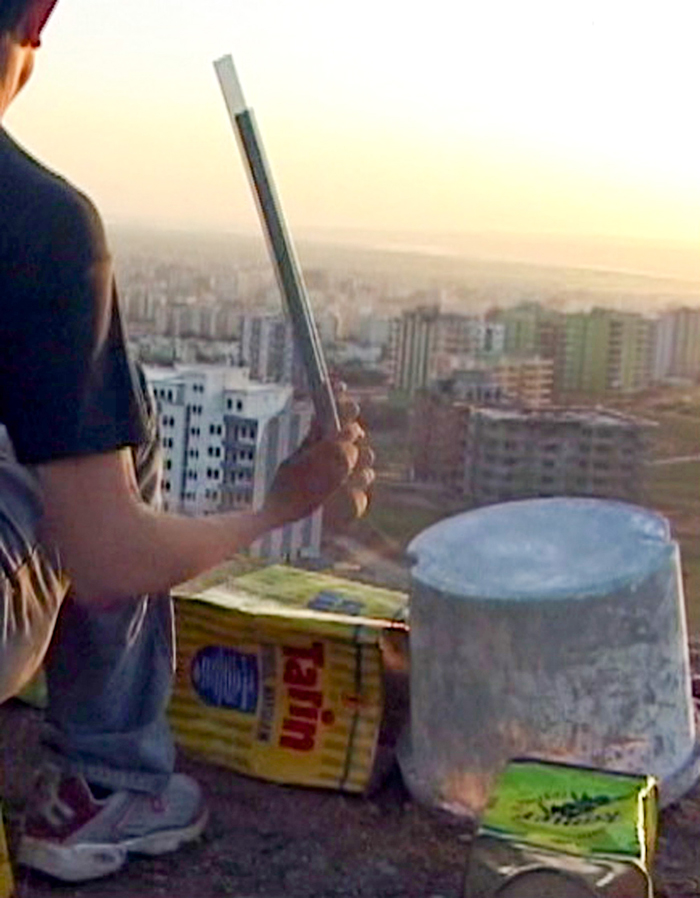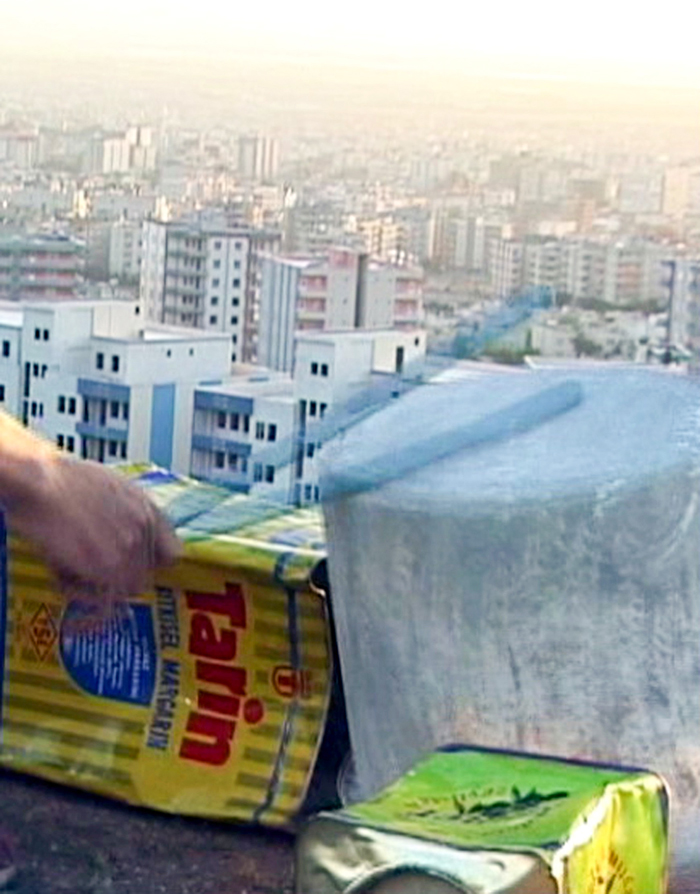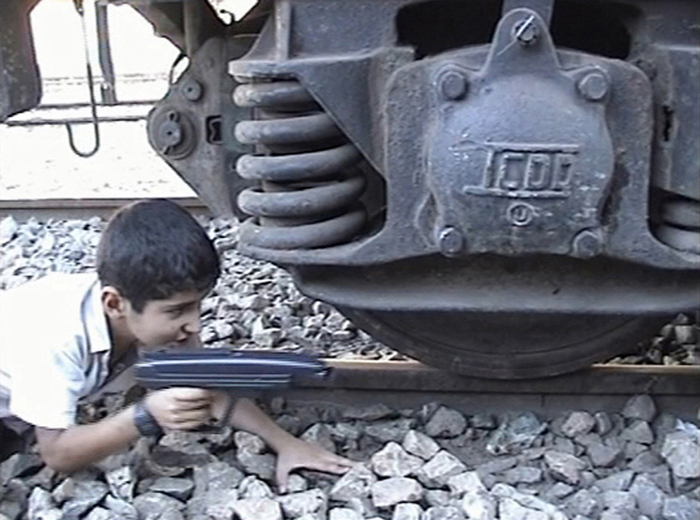Fikret Atay’s video Tinica (2004, 7:32 min) presents one of the most memorable images of recent years: a lone young man on a plateau, drumming while overlooking a forlorn city. The boy beats, and at times thrashes, a drum set made of quotidian refuse. While driving his way through an entrancing rhythm, his sticks are blurred by a speed the camera cannot catch. There are tin canisters that once held cooking oil, another that held margarine, cymbals constructed of tin scrap set upon the ground, and an overturned gray bucket resting on two worn sneakers. The boy holds two drumsticks, hard plastic tubes, pelting and pounding items he has forced into instrumentation, steadily building his beat to a crashing crescendo.
Tinica opens with a view of Batman, a city in eastern Turkey where the Kurdish Atay lives and works. We view Batman from atop one of the lush, green, rolling hills that surround it. It is sundown. The light is hazy; polluted orange, purple and yellow permeate the screen with a dull brilliance distinct to video. Below this bluff is the city, its edge marked by a gathering of high-rise housing projects (notable less for their particularity than their global mediocrity). The teenage drummer enters and builds his drum set, and soon a friend follows, handing him an unmarked soda bottle before returning off- screen. (The bottle has that unmistakable Coca-Cola shape, yet one would be hard pressed to anticipate a verse of “I’d like to teach the world to sing” emerging from this mount.) As the boy drums, a rhythm takes hold that is offbeat and not quite steady. The teenager’s eyes are fixated on the city beneath him. Atay’s camera moves silently around capturing the enraptured drummer’s face, and the dim environs he serenades. As the tin canisters are abused to ruin, the rhythm becomes intoxicating and ancient. The beat quickens rapidly. Suddenly, the boy stands and kicks the cans, the bucket, and the shoes, joining a lineage that would include Pete Townsend and the Fluxus Festival of Misfits. Atay’s lens follows the destroyed makeshift drum set in its descent to the stony bottom of the plateau, coming to rest at a turbulent edge of town.

Atay, born in 1976, has been exhibiting for the past three years and the video works recently shown at the Hammer (in his first solo exhibition in the United States) consist of half the works he has made thus far. All of Atay’s works are produced on video, short in length, and shot in and around Batman. The primary audio source is music, or rhythmic sounds emanating from those on screen. Atay substitutes rhythm for language, an act that bestows these sounds with an insurgent alterity of steadfast local culture. Atay’s images of his distinct Kurdish culture counteract what appear (in Tinica at least) as a product placement for global economy: the Coke bottle, the anonymous third world architecture, and the music video form. Tinica is a remedy for the current global affect characterized by the homogeneous desires of Western, capitalist culture, an affect exemplified by the global Biennial art exhibition. Typified by recent spectacles such as Documenta 11, which emphasized the “creolization” and “hybridization” of our, supposedly, increasingly dedifferentiated and borderless world, these exhibitions deny the local for what may be a red herring: an overarching, universal and urban aesthetic.1 With his introduction to the greater world of contemporary art through 2003’s Istanbul Biennial, and an ensuing circulation in similar venues, Atay counters the globalized management of aesthetic discourse from within. As with the two other videos on view at the Hammer, Tinica is a work of defiance, one of resistant territory, and of localism in the face of global concession.
Atay’s global product placement is complicated by the very location of the drummer atop a plateau. On a hard and solid earthen mound that denotes the limit of a mid-sized, third world city the drummer plots a rhythm at the edge of a globalizing world. This edge, defined as much by the video screen as by the border of Batman demarcated by the plateau, separates the Kurdish territory Atay delimits with his videos and, respectively, the environment of said international exhibition or an encroaching Turkish political landscape. Still, Atay’s outcropping counters Gilles Deleuze and Felix Guattari’s haunting, metaphorical mesa. Architectural critic Ignasi de Sola-Morales has concisely described Deleuze and Guattari’s concept of the plateau as “the nonexistence of a platform from which it is possible to construct a vision of the world. There is no such platform, but rather mille plateaux (a thousand plateaus), a limitless multiplicity of positions from which it is possible only to erect provisional constructions.”2 Atay’s plateau is a more stable structure. This earthen presence seems an answer to a previously unasked question: What could Deleuze’s plateau look like? The drummer’s heavy rhythm delimits a boundary, a place between here and there. Atay’s mediation of this rhythmic action solidifies the Kurdish cultural state as a definite platform. The sounds of the beat materialize the schism between the Kurds, who seek the self- expression of their thousands of years old culture, and those outside who seek to expunge and deterritorialize such traditions. Atay formulates Kurdish culture as a world constructed of video screens rather than arbitrary political lines on a map.

Atay operates from the standpoint of a Kurdish minority culture in a region whose government seeks to suppress that culture to the point of banishment. In the modern era the Kurds have never held their own country. They are subdivided between several countries in central Asia: Iraq, Syria, Iran, and most prominently, Turkey. In a statement published for the 2003 Istanbul Biennale, Atay noted, “I get pleasure from producing art in the context of the impossible.”3 His videos reflect the unease within Batman, a militarized city with a majority Kurdish population under constant surveillance by the Turkish authorities. Kurds in Turkey are not only held under suspicion, they are not granted freedom of expression nor permitted to learn their own language through public education. There is no border when you reach the Kurdish landscape, no signs and no guidebooks. Atay, however, creates a border, and maps out a cultural topography bound by the lens of his video camera. Presented alongside Tinica at the Hammer were Bang! Bang! (2003, 2:17 min) and Rebels of the Dance (2002, 10:52 min). The videos are simple and unrefined. Atay employs amateurs and the audio focuses on rhythm to define a culture whose language does not officially exist. Sounds may emerge from a drum, from children mocking the sound of a gun (Bang! Bang!), chanting traditional song (Rebels of the Dance), or young women dancing (as in Fast and Best, 2002, not on view at the Hammer). Each video appears staged, yet it is difficult to gauge the extent of such preparations. The players involved never strike us as fully aware of why they are being taped. There is an air of suspicion and mystery. We find this in the faces of those on camera, and the brisk and abrupt nature in which actions are recorded and, in turn, presented to us.

The two young boys in Rebels of the Dance (2002, 10:52 min) display an awkwardness in front of the camera that belies the openness of their recorded actions. Rebels opens with a shot of an ATM, taken from inside the machine’s cramped booth. Atay’s camera turns to the door, which opens. The boys enter, and others peer curiously from outside (one quickly dashes out of our view). They squat beneath a wall perpendicular to the ATM, and with their mouths not moving, the boys begin to sing. It is a sound made on the inside of the mouth, combining a hum and the tongue against the roof of the mouth. The sound is alien, nearly electronic — a human appropriation of the electronic. The sounds fall in and out of dissonance and resonance. One boy rises and saunters around the room, continuing his song. He turns and dances a few steps. The moves and the sounds are of the Kurdish tradition. As both boys stand and sing, they catch each others glances, fiddle with the keys of the ATM machine, and exchange several self-aware moments with the camera and others outside. At one moment, nearing the end of the video, we hear someone behind the camera, “pshhh.” The boys turn, glance beyond the camera; this is their signal to end. They slowly make their way back towards the wall where they began. That final hush and glance recurs in Bang! Bang! Here we open to two boys lying on the ground. They lie beneath still, gray train cars, and gaze away from us down a dirt and rock strewn path. Sounds emerge; “CH-CH-CH-CH,” “CHOU-CHO-CHOU,” and in the distance “CHA-CHA,”“CH-CH- CH.” One boy hops to his feet and takes on a more aggressive position. The other soon follows. They pursue their two peers with black, plastic weaponry, chasing them down for the kill. The opponents fall to the ground. Another pursuit is filmed. This time the boys travel over the end of a rail car. Atay follows. As they descend the rail cars’ steps, one boy glances over his shoulder directly into the camera. It is a slight look, but one of awareness of another out there, watching.
The discreet glances Atay captures are subtle, but they are glances as much to us as they are to the artist. Each glance lends itself to an overall tension. The filmmaker anticipates the action of his players, as the players anticipate the artist’s movement. Yet these suspicious eyes are hardly caused by a strenuous relationship between the director and his actors. The work is not staged any more than a simple direction, and it is done with quietness and quickness. The hasty glances belie self-awareness within a state suspicious and unconvinced of the autonomy of the Kurdish culture. Atay’s players trust the artist’s camera but there are other cameras they view with distrust.
Atay has written, “When the film is over existence ends.”4 In his deceptively simple words, Atay expresses the operation of his films: the creation of boundaries through the act of recording. The young artist simultaneously creates and captures a culture Turkish authorities would prefer eliminated. From within the undisclosed location that is Kurdish culture in Turkey, Atay gives this world definition. Atay forms a plateau of certainty, one that attests to Maurice Blanchot’s statement, “The gratifying aspect of the image is that it constitutes a limit at the edge of the indefinite.”5 Atay works in terminal and indeterminate spaces: ATM booths, rail yards, the edge of town, and there finds a resistant territory. Yet it is not the actual landscape that is resistant, but the cultural landscape whose testimony we view in these discreet videos. Atay’s lens is a mechanism constructed for outward dissemination and a covert, inward circulation. These videos are a hidden eye, the surveillance of a location not lost to its own regenerations, but rather threatened by the indiscretions of deterritorializing regimes.
Chris Balaschak is a writer living in Los Angeles.
